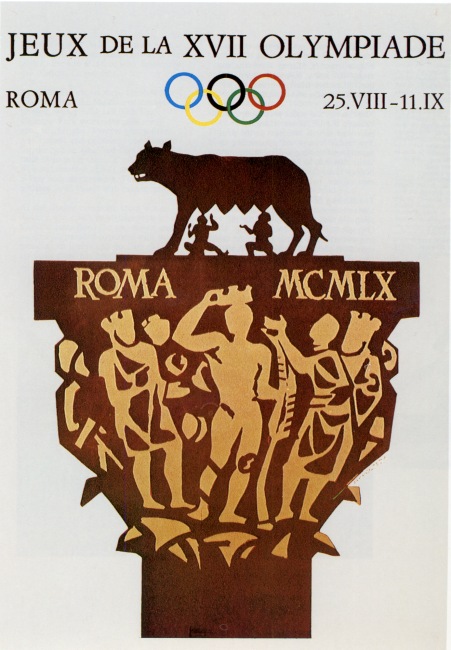Poster

| Design by: | Armando Testa |
|---|---|
| Size: | 70 x 99,5 cm |
| Copies: | 290.000 |
| Comment: | Published in 11 languages |
Competition for the Poster 1960 On 31st January 1957 the Arts Section iniziated a " Prize-winning Contest between artists of Italian nationality for the poster intended to exalt the Games of the XVII Olympiad ". The proclamation stipulated that the designs entered should represent an allegory containing the following essential elements: (a) the idea of Olympic sport at Rome: (6) the five Olympic rings; (c) the wording "Games of the XVII Olympiad-Rome-MCMLX". The 16th July 1957, on the proposal of the Arts Committee, the Examining Jury was appointed under the Chairmanship of Mr. Roberto Roberti, President of the Italian Professionals and Artists Union and composed of Prof. Carlo Giulio Argan, art critic, Mr. Mino Maccari, painter, Mr. Domenico Purificato, painter, Prof. Alfredo Lalia, commercial artist, representative of the Italian Advertising Federation, Dr. Marcello Garroni, Secretary-General of the Games, Dr. G. B. Fabjan, Vice-Secretary General of the Italian National Olympic Committee and Dr. Romolo Passamonti. 212 Competitors and 249 Designs. 212 competitors, with 249 designs, were entered for the contest. By an announcement of 9th August 1957, the Jury found that none of the works presented was in line with its requirements and decided not to award any prize. At the same time it suggested that a second competition be held, announcing the names of twelve poster artists as competitors. The conclusions of the Jury were approved by the Arts Committee and, subsequently on 5th November 1957, also by the Presidency of the C.O.N.I. The same Jury examined the works of the seven participants in the competition out of the twelve invited, i.e. Erberto Carboni, Carmelo Cremonesi, Augusto Favalli, Paolo Garretto, Marcello Nizzoli, Saverio Pozzati, Gian Rossetti, Armando Testa, Pino Tovaglia, Dante Vernice, Luigi Veronesi and Franco Grignani and, by its announcement of 10th January 1958, judged the work of Armando Testa of Turin to contain the best artistic solution of those presented by the seven participants. However, when the vote of the Jury was passed for ratification to the Executive Committee of the C.O.N.I., this latter body, in its meeting of 22nd January 1958, was of the opinion that the design in question did not completely fulfil their requirements and authorised the awarding of the prize, at the same time inviting the Arts Section to seek an arrangement with some highly qualified Italian artist for the elaboration of the design. Thus, the Arts Committee in its meeting of 6th February 1958 took note of the decisions of the Jury and the remarks of the Committee of the C.O.N.I. and in view of the fact that the twelve most qualified Italian poster artists had already been invited to take part in the second stage of the contest, decided to propose to the author of the winning design, Armando Testa, that certain modifications be made which, while preserving the fundamental inspiration and realization of the work whose originality, impact, and artistic value they recognised, would simplify a number of details of execution. For this the artist Testa was approached, but the Executive Committee of the C.O.N.I. still did not express itself satisfied. The Executive Committee then decided to establish what they wanted in the poster, namely: a pillar with capital and the Capitoline Wolf as symbols of its Roman character, the five Olympic rings and the prescribed wording. Among the designs presented on this theme the best was, once again, judged to be that of Testa, who produced a modern interpretation of the Belvedere Capital showing a scene of acclamation to a winning athlete of the III century B. C. Testa's final design, having been approved by the Arts Committee and the Executive Committee of the C.O.N.I., was adopted and used for the Official Poster of the Games of the XVII Olympiad. Distribution of the poster was undertaken by the Press Services Section. The Wolf, which was the badge of the Romans before Marius' second Consulship, is represented in the celebrated bronze in the Museum of Palazzo dei Conservatori on the Capitol in the act of suckling Romulus and Remus; the work bears witness to the conventionalism of Etruscan art in the VI century B. C. inspired by Greco-Ionic models and is attributable most probably to the School of Veio. The suckling twins are, however, more modern, being the work of Guglielmo della Porta and Antonio del Pollaiolo. The Capitoline Wolf, which inspired the creation of the official symbol, was reproduced and the various models used for the different decorative requirements of the Olympic organisation. (Source document: Official Report 1960, Vol. I., page 299) |